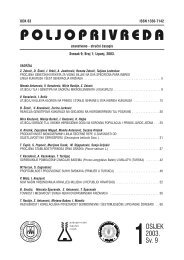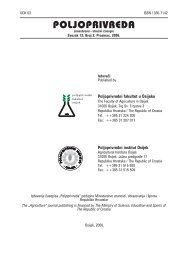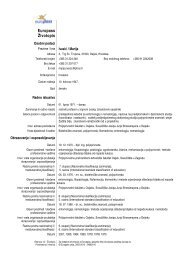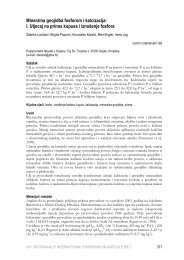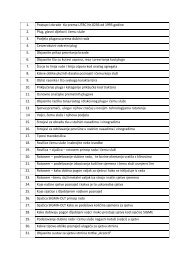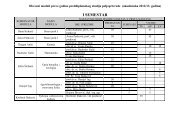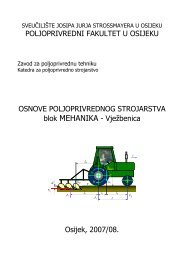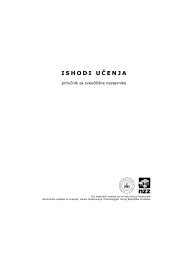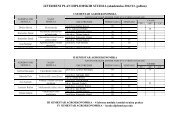c:\Temp\PDF_RTF\poljoprivreda\Poljoprivreda 1-2001\Poljoprivreda ...
c:\Temp\PDF_RTF\poljoprivreda\Poljoprivreda 1-2001\Poljoprivreda ...
c:\Temp\PDF_RTF\poljoprivreda\Poljoprivreda 1-2001\Poljoprivreda ...
Create successful ePaper yourself
Turn your PDF publications into a flip-book with our unique Google optimized e-Paper software.
10 Agriculture 7(2001)<br />
ISSN 1330-7142<br />
UDK = 631.523.11:633.11<br />
PLEIOTROPIC EFFECT OF Rht3 DWARFING GENE ON SOME TRAITS OF<br />
WHEAT (Tr. aestivum L. em Thell)<br />
M. Jo{t, Vesna Samobor, S. Sre~ec<br />
SUMMARY<br />
Izvorni znanstveni ~lanak<br />
Original scientific paper<br />
True-isogenic lines, differing only in the semi-dominant Rht 3 dwarfing gene, were developed<br />
from the cross ’Tom Thumb x Bankuty 1201’ during 17 years of continuous selection on heterozygous<br />
semi-dwarf plant. The effect of double (Rht 3 Rht 3 = full-dwarf), single (Rht 3 rht 3<br />
=semi-dwarf), or no dwarfing gene (rht 3 rht 3 = tall) dosage on some plant, seed, and flour<br />
quality traits were observed in the isogenic lines during two years field experiment, planted by<br />
’honey-comb design’ at Kri`evci, Croatia. Significant main effect of Rht 3 gene was in shortening<br />
of plant height by 54% and 28% in double and single gene dosage respectively.<br />
Full-dwarf genotype (Rht 3 Rht 3 ) had by 12% more heads/plant, but the other yield components<br />
as number of grains/head, and grain weight/head were lower by 25 and 28% respectively, resulting<br />
in significantly lower grain yield/plant (-27%). However, this also could be a secondary<br />
side effect of prolonged vegetation influenced by doubled Rht 3 gene. There was no<br />
significant effect on flour protein content. Double gene effect was strong and significant for<br />
maximum dough viscosity measured by amylograph in BU (101%). In our environment full<br />
dwarf (Rht 3 Rht 3 ) has no agronomic value, but single gene dosage could be of commercial interest<br />
in hybrid wheat breeding.<br />
Key-words: wheat - Triticum aestivum, dwarfism, Rht 3 gene, pleiotropic effect, yield components,<br />
grain yield, protein content, amylogram<br />
INTRODUCTION<br />
There is a general opinion that, discovery of dwarfing<br />
genes and replacement of conventional tall wheat cultivars<br />
by semi-dwarf ones, contributed to increase grain yield<br />
(Pugsley, 1983, Pinthus and Levy, 1984, Gale and Youssefian,<br />
1984, Worland et al., 1990, Gent and Kiyomoto,<br />
1998). In spite of the fact that over twenty different dwarfing<br />
genes have been identified so far (McIntosh, 1988),<br />
only five of them are extensively used in World-wide cultivated<br />
wheat varieties. These are: Rht 1 and Rht 2 , (known as<br />
’Norin 10’), Rht 1 (B.dw) (known as Bezostaya 1 dwarf),<br />
Rht 8 (known as ’Akakomugi’) and Rht 1 S gene (known as<br />
Saitama 27). All of them, except Rht 1 (B.dw.) originated<br />
from Japanese germplasm. While Rht 1 and Rht 2 are common<br />
in American, Australian and West-European cultivars,<br />
Rht 8 and Rht 1 S are prevalent in South-European<br />
cultivars (Worland and Law, 1986). There were trials where<br />
some other Rht dwarfing genes were used, but without<br />
significant success (Worland et al., 1980). For now, only<br />
strong dwarfing allel Rht 3 (known as ’Tom Thumb’ or ’Minister<br />
dwarf’ gene) has shown some breeding value, at least<br />
for hybrid wheat (Gale et al., 1989). The major genes<br />
Rht 1 and Rht 2 were located on chromosomes 4AS (McVittie<br />
et al., 1978, McIntosh, 1988) and 4DS (Gale et al.,<br />
1975, McIntosh, 1988) respectively. The dwarfing gene<br />
Rht 3 was also located on 4AS chromosome. It was multiple<br />
allele with Rht 1 , Rht 1 S and Rht 1 (B.dw.) since all of them<br />
share a common locus of the same chromosome (Morris<br />
et al., 1972, Gale et al., 1975, Worland and Petrovi},<br />
1988). The Rht 1 and Rht 2 are dominant genes, and the<br />
third Rht 3 is semi-dominant gene with strong dwarfing effect.<br />
All of the three have a pleiotropic effect on plant’s insensitivity<br />
to exogenous gibberellic acid. The dwarfing<br />
gene Rht 8 , common in South-European germplasm, has<br />
been located on chromosome 2DL, and unlikely to previously<br />
mentioned ’Norin 10’ and ’Tom Thumb’ dwarfing genes,<br />
it is recesive height promoting gene (Worland and<br />
Law, 1985) and do not confer insensitivity to exogenous<br />
gibberellic acid (Worland and Law, 1986). The Rht 1 S is a<br />
weak source of giberelic acid insensitivity derived from cv.<br />
Saitama 27.<br />
The interest for using Rht 3 gene in breeding work was<br />
renewed after discovery of its ability to inhibit the release<br />
of the enzyme a-amylase in germinated grain, the trait im-<br />
Prof.dr.sc. Marijan Jo{t, mr.sc. Vesna Samobor and mr.sc. Sini{a Sre~ec -<br />
Agricultural College Kri`evci, M.Demerca 1, 48260 Kri`evci



